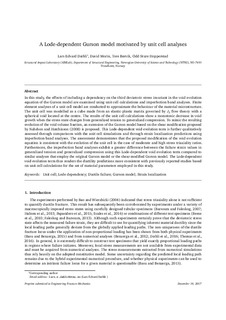| dc.contributor.author | Dæhli, Lars Edvard | |
| dc.contributor.author | Morin, David | |
| dc.contributor.author | Børvik, Tore | |
| dc.contributor.author | Hopperstad, Odd Sture | |
| dc.date.accessioned | 2018-02-15T15:10:03Z | |
| dc.date.available | 2018-02-15T15:10:03Z | |
| dc.date.created | 2018-01-17T20:28:39Z | |
| dc.date.issued | 2017 | |
| dc.identifier.citation | Engineering Fracture Mechanics. 2018, 190, 299-318. | nb_NO |
| dc.identifier.issn | 0013-7944 | |
| dc.identifier.uri | http://hdl.handle.net/11250/2485130 | |
| dc.description.abstract | In this study, the effects of including a dependency on the third deviatoric stress invariant in the void evolution equation of the Gurson model are examined using unit cell calculations and imperfection band analyses. Finite element analyses of a unit cell model are conducted to approximate the behaviour of the material microstructure. The unit cell was modelled as a cube made from an elastic-plastic matrix governed by J2 flow theory with a spherical void located at the centre. The results of the unit cell calculations show a monotonic decrease in void growth when the stress state changes from generalized tension to generalized compression. To mimic the resulting evolution of the void volume fraction, an extension of the Gurson model based on the shear modification proposed by Nahshon and Hutchinson (2008) is proposed. This Lode-dependent void evolution term is further qualitatively assessed through comparisons with the unit cell simulations and through strain localization predictions using imperfection band analyses. The assessment demonstrates that the proposed modification of the void evolution equation is consistent with the evolution of the unit cell in the case of moderate and high stress triaxiality ratios. Furthermore, the imperfection band analyses exhibit a greater difference between the failure strain values in generalized tension and generalized compression using this Lode-dependent void evolution term compared to similar analyses that employ the original Gurson model or the shear-modified Gurson model. The Lode-dependent void evolution term thus renders the ductility predictions more consistent with previously reported studies based on unit cell calculations for the set of material parameters employed in this study. | nb_NO |
| dc.language.iso | eng | nb_NO |
| dc.publisher | Elsevier | nb_NO |
| dc.rights | Attribution-NonCommercial-NoDerivatives 4.0 Internasjonal | * |
| dc.rights.uri | http://creativecommons.org/licenses/by-nc-nd/4.0/deed.no | * |
| dc.title | A Lode-dependent Gurson model motivated by unit cell analyses | nb_NO |
| dc.type | Journal article | nb_NO |
| dc.type | Peer reviewed | nb_NO |
| dc.description.version | acceptedVersion | nb_NO |
| dc.source.pagenumber | 299-318 | nb_NO |
| dc.source.volume | 190 | nb_NO |
| dc.source.journal | Engineering Fracture Mechanics | nb_NO |
| dc.identifier.doi | 10.1016/j.engfracmech.2017.12.023 | |
| dc.identifier.cristin | 1545823 | |
| dc.description.localcode | © 2017 Elsevier Ltd. All rights reserved. This is the authors' accepted and refereed manuscript to the article, locked until 22 December 2019 due to copyright restrictions. | nb_NO |
| cristin.unitcode | 194,64,45,0 | |
| cristin.unitname | Institutt for konstruksjonsteknikk | |
| cristin.ispublished | false | |
| cristin.fulltext | postprint | |
| cristin.qualitycode | 1 | |

